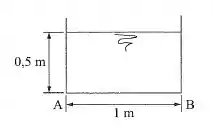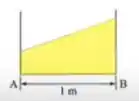Um veículo move-se com velocidade constante de para a direita, carregando um recipiente retangular aberto que contém água. O veículo é freado em até parar com desaceleração constante. Dados: ; ; não há transbordamento. Determinar:
- A inclinação da superfície livre em relação à horizontal, durante a frenagem;
- A pressão nos pontos e durante a frenagem.

Passo 1
Oi pessoal, tudo bem? Vamos analisar essa questão.
Durante a frenagem o líquido irá se deslocar formando um prisma trapezoidal como da figura abaixo:

Como a aceleração é constante, temos que:
Sendo a velocidade final igual a zero e a velocidade inicial do movimento de frenagem igual a , temos que:
Passo 2
Pela teoria, sabemos que:
Substituindo os valores, temos que:
Portanto:
Passo 3
O item b, nos pede a pressão nos pontos e . A expressão que calcula a diferença de pressão em dois pontos é:
Substituindo as variáveis conhecidas, temos que:
Como não houve derramamento de líquido durante a frenagem, temos que a área do líquido no primeiro momento tem que ser igual a área do líquido no segundo momento. Portanto:
Multiplicando por , temos que:
Somando as duas equações, temos que:
E: